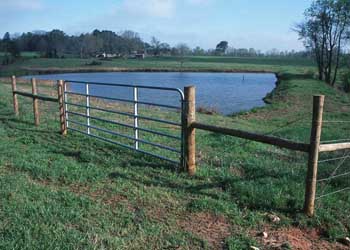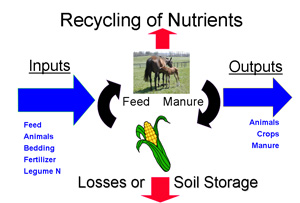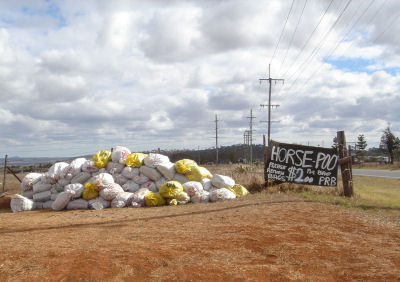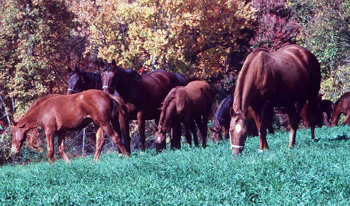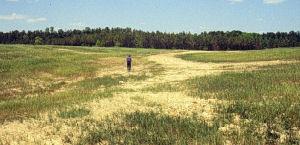Why Look at Environmental Practices of Horse Farms?
Equine farms are often small acreages that may not have ready access to technologies and information appropriate to their farms. Westendorf et al. (2010a) found that many equine farmers use extension services less than other sources of information, but they may use feed stores or neighbors for information (Table 1); Marriott et al. (2012) also found a limited understanding of available conservation resources among equine farmers. Best Management Practice (BMP) adoption on equine farms is the focus of this paper.
Related: Managing Manure on Horse Farms
|
Table 1. Manure management information sources on equine farms (Total Respondents – 442) |
||||||
|---|---|---|---|---|---|---|
| Another Horse Farmer | Trade Magazines | Cooperative Extension | Other | Feed Dealer | Internet | Other Retailer |
| 221 | 183 | 229 | 116 | 97 | 89 | 26 |
|
Westendorf et al. (2010a,b) |
||||||
What did we do?
Equine farms generally dry stack their waste; in a NJ survey (Westendorf, et al. 2010b) over 70% of farms indicate storing manure on farm, many of these sites may lack BMP’s appropriate for a storage (Table 2, 3). Eighty-three percent in this survey had manure storages located greater than 61m from water or wetlands, and 86% had storages located greater than 61m from neighbors; this might indicate their storage does not pose a significant water quality or nuisance risk. Fiorellino et al. (2010) found that even with low levels of BMP adoption, most equine farms had a reduced water quality risk. Over 50% of NJ farmers indicate that they compost manure, but it is my observation that few actually do; the definition of compost may vary from mature compost to rotting decomposition. Seventy-five percent of farms bed with wood shavings, 25% with straw and the remainder with a combination of wood chips, wood pellets, and paper.
Table 2. Percentage of New Jersey equine survey farms implementing various management practices (%) |
||||||||||||
|---|---|---|---|---|---|---|---|---|---|---|---|---|
Spread manure on farm |
Manure storage area |
Compost horse manure |
Off-farm manure disposal |
Maintain and use dry lot areas |
Credit manure as a fertilizer |
Regular soil tests |
Drag pastures regularly |
Clean stalls daily |
Manure storage <50 ft. from water |
Manure storage >200 ft. from water |
Manure storage <50gt. from neighbor |
Manure storage >200 ft. from neighbor |
54 |
74 |
47 |
58 |
47 |
39 |
32 |
75 |
70 |
1.1 |
83.2 |
1.1 |
86.4 |
|
Westendorf, et al. (2010b) |
||||||||||||
|
Table 3. Percentage of equine survey farms spreading or storing manure (%) |
||
|---|---|---|
| No. of horses | Spread Manure (n = 442) | Manure Storage (n = 434) |
| 1 to 2 | 55.2 | 65.3 |
| 3 to 5 | 59.2 | 62.9 |
| 6 to 10 | 55.3 | 80.7 |
| 11 to 20 | 50.0 | 87.9 |
| 21 to 40 | 37.8 | 94.4 |
| > 40 | 37.5 | 93.3 |
|
Westendorf, et al. (2010b) |
||
Nearly 60% of horse farms dispose of some manure off the farm; for use as fertilizer, to a centralized composter, on-farm compost for sale, or to be given away are the prime means of disposal; unfortunately some is removed by dumpster. Fifty-four percent spread some manure on-farm, of these only 39% account for any fertilizer value. If we trust the survey, then probably only 20-25% of the farms have an understanding of the fertilizer value of manure; this survey did find a positive correlation between manure spreading and soil testing (P<.05), suggesting some understanding of soil fertility basics.
Fifty-three percent of farms had a sacrifice or exercise lot that provides horses an area for eating, drinking, shelter, and relaxing if needed. A sacrifice area can help to protect pasture and grazing areas. Many farms only have a turnout lot for both exercise and grazing; this can result in greater mud accumulation and other possible water quality concerns.
A feed management survey (Westendorf, et al. 2013) was sent to 500 NJ equine farmers (see Table 4). Forty-five percent received feeding and nutrition information from a feed store, 20% from a veterinarian, only 3% from a professional consultant and 2% from extension. Most farmers had no concept of feeding to reduce excretion of nutrients such as phosphorus. Monitoring intake, cleaning feed bunks and contaminated lots regularly, and disposing all waste feed in the manure storage are good recommendations for all producers. Please see the Williams et al. (2015) abstract in the poster session for more information about an on-farm feeding project.
|
Table 4. Description of how feeding decisions are made (%) |
|||||
|---|---|---|---|---|---|
| Balance diets on your own | Veterinarian advice | No plan at all | Feed store advice | Consulting nutritionist | Extension advice |
| 45 | 20.5 | 15 | 14.5 | 3 | 2 |
|
Westendorf, et al. 2013 |
|||||
What have we learned?
In summary: 1. Many horse farms dispose some or all manure off-site; 2. Between 50 and 75% spread manure on crop or grazing land; 3. Most have at least a designated location for manure storage; 4. Larger farms are more likely to store manure. 5. Many farms have a low non-point source (NPS) pollution risk, but little understanding of BMP’s; and 6. Pasture management BMP’s are seldom applied.
Future Plans
Outreach should focus on the implementation of low-cost management practices that equine farmers are likely to adopt.
Author
Michael L. Westendorf, Extension Specialist in Animal Science, Rutgers, the State University of New Jersey westendorf@aesop.rutgers.edu
Reference
Fiorellino, N. M., J. M. McGrath, B. Momen, S. K. Kariuki, M. J. Calkins and A. O. Burk. 2014. Use of Best Management Practices and Pasture and Soil Quality on Maryland Horse Farms. J. Equine Vet. Sci. 34:257-264.
Marriot, J. M., A. Shober, P. Monaghan and C. Wiese. 2012. Equine Owner Knowledge and Implementations of Conservation Practices. J. of Extension. 50: Issue 5. https://archives.joe.org/joe/2012october/pdf/JOE_v50_5rb4.pdf
Westendorf, M. L., T. Joshua, S. J. Komar, C. Williams, and R. Govindasamy. 2010a. Effectiveness of Cooperative Extension Manure Management Programs. J. Equine Vet. Sci. 30:322-325.
Westendorf, M. L., T. Joshua, S. J. Komar, C. Williams, and R. Govindasamy. 2010b. Manure Management Practices on New Jersey Equine Farms. Prof. Anim. Sci. 26:123-129.
Westendorf, M. L., V. Puduri, C. Williams, T. Joshua, and R. Govindasamy. 2013. Dietary and Manure Management Practices on Equine Farms in Two New Jersey Watersheds. J. Equine Vet. Sci. 33:601-606.b
Acknowledgements
This work supported by the New Jersey State Equine Initiative, the Rutgers Equine Science Center, and the New Jersey State Department of Agriculture.
Special thanks to Troy Joshua, USDA-NASS, New Jersey for help in setting up some of the surveys.
The authors are solely responsible for the content of these proceedings. The technical information does not necessarily reflect the official position of the sponsoring agencies or institutions represented by planning committee members, and inclusion and distribution herein does not constitute an endorsement of views expressed by the same. Printed materials included herein are not refereed publications. Citations should appear as follows. EXAMPLE: Authors. 2015. Title of presentation. Waste to Worth: Spreading Science and Solutions. Seattle, WA. March 31-April 3, 2015. URL of this page. Accessed on: today’s date.


